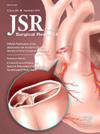Vascular Graft Infections Treated With Bioabsorbable Antibiotic Beads
IF 1.8
3区 医学
Q2 SURGERY
引用次数: 0
Abstract
Introduction
Inguinal vascular surgical site infections (VSSI) and infected prosthetic grafts remain a critical problem in vascular surgery. Prior clinical reports suggest antibiotic-impregnated beads may be used to attempt salvage of the graft and improve outcomes, especially if explant would result in major amputation or mortality. Described is our institutional experience managing inguinal VSSI using bioabsorbable, antibiotic-impregnated beads compared to inguinal VSSI managed with debridement alone.
Methods
Patients with VSSIs after lower-extremity procedures were identified through the institutional database and departmental registries from 2014 to 2023. Cases were excluded if they did not involve an inguinal wound infection or an operation for VSSI management. Outcomes, including amputation-free survival, reinfection, and re-operation for infection were recorded, along with microbial isolates. Basic descriptive statistics, Kaplan–Meier, and Multiple variable Cox proportional hazards analyses were performed.
Results
There were 43 patients identified (23 with intravenous antibiotics and debridement alone, and 20 treated with intravenous antibiotics, debridement, and antibiotic beads). The two groups differed significantly in their Szilagyi classification, with thirteen patients (65%) with class III infections in the antibiotic bead group compared with one (7%) in the debridement alone group. There was no significant difference in amputation-free survival for those cases that received debridement and antibiotic beads versus debridement alone (P = 0.20) or amputation-free survival between Szilagyi classifications (P = 0.47) despite a higher representation of Szilagyi III cases in the antibiotic bead group (P = 0.0001). Patients with graft infections treated with beads experienced similar survival outcomes to patients with subcutaneous infections treated with debridement alone (P = 0.21).
Conclusions
The efficacy of bioabsorbable antibiotic beads in VSSIs remains controversial. While this cohort study demonstrated an increased risk of re-infection, this is confounded by the antibiotic bead group having a higher frequency of graft infections. Antibiotic beads appear to be safe for use in patients with vascular graft infections and may help achieve outcomes comparable to patients without graft involvement. Further studies with larger patient populations and similar infection severity between groups are needed.
用生物可吸收抗生素珠治疗血管移植感染。
导言:腹股沟血管手术部位感染(VSSI)和假体移植物感染仍是血管外科的一个严重问题。之前的临床报告显示,抗生素浸泡珠可用于挽救移植物并改善预后,尤其是在切除移植物会导致重大截肢或死亡的情况下。本院使用生物可吸收抗生素浸渍珠处理腹股沟 VSSI 的经验与单纯清创处理腹股沟 VSSI 的经验进行了比较:2014年至2023年期间,通过机构数据库和部门登记册确定了下肢手术后发生VSSI的患者。如果病例未涉及腹股沟伤口感染或未进行VSSI处理手术,则将其排除在外。结果包括无截肢存活率、再感染和因感染而再次手术,微生物分离物也一并记录在案。对结果进行了基本描述性统计、Kaplan-Meier 和多变量 Cox 比例危险度分析:共发现 43 例患者(23 例仅接受静脉注射抗生素和清创术,20 例接受静脉注射抗生素、清创术和抗生素珠治疗)。两组患者的 Szilagyi 分类差异很大,抗生素珠组有 13 名患者(65%)属于 III 级感染,而单纯清创组只有 1 名患者(7%)属于 III 级感染。接受清创和抗生素微珠治疗的病例与仅接受清创治疗的病例在无截肢存活率(P = 0.20)或无截肢存活率(P = 0.47)方面没有明显差异,尽管抗生素微珠组中 Szilagyi III 级病例的比例更高(P = 0.0001)。使用微珠治疗移植物感染的患者与仅使用清创术治疗皮下感染的患者存活率相似(P = 0.21):结论:生物可吸收抗生素珠对 VSSI 的疗效仍存在争议。虽然这项队列研究显示再感染风险增加,但抗生素珠组发生移植物感染的频率较高,这就混淆了再感染风险。在血管移植物感染患者中使用抗生素珠似乎是安全的,而且可能有助于获得与未受移植物影响的患者相当的治疗效果。还需要对更大的患者群体和不同组别之间相似的感染严重程度进行进一步研究。
本文章由计算机程序翻译,如有差异,请以英文原文为准。
求助全文
约1分钟内获得全文
求助全文
来源期刊
CiteScore
3.90
自引率
4.50%
发文量
627
审稿时长
138 days
期刊介绍:
The Journal of Surgical Research: Clinical and Laboratory Investigation publishes original articles concerned with clinical and laboratory investigations relevant to surgical practice and teaching. The journal emphasizes reports of clinical investigations or fundamental research bearing directly on surgical management that will be of general interest to a broad range of surgeons and surgical researchers. The articles presented need not have been the products of surgeons or of surgical laboratories.
The Journal of Surgical Research also features review articles and special articles relating to educational, research, or social issues of interest to the academic surgical community.

 求助内容:
求助内容: 应助结果提醒方式:
应助结果提醒方式:


